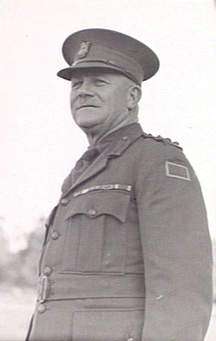George Furner Langley
| Brigadier George Furner Langley CBE DSO | |
|---|---|
 Brigadier George Langley, commander of 2nd Australian Infantry Brigade, 13 July 1943 | |
| Born |
1 May 1891 South Melbourne, Victoria |
| Died |
24 August 1971 (aged 80) Killara, New South Wales |
| Allegiance |
|
| Service/branch |
|
| Rank | Brigadier |
| Commands held |
14th Light Horse Regiment 2nd Infantry Brigade |
| Battles/wars | |
| Awards |
Commander of the Order of the British Empire Distinguished Service Order & Bar Mentioned in Despatches (3) |
Brigadier George Furner Langley, CBE, DSO, (1891–1971) was an Australian soldier who served in both the First and Second World Wars. He was also an educationist, and the headmaster of a number of high schools in Victoria.
Early life
Langley was born on 1 May 1891 in Port Melbourne. He gained a Bachelor of Arts degree from the University of Melbourne and teaching qualifications from Melbourne Teachers' College[1] and taught at Williamstown High School, then at the Mansfield Agricultural High School in Mansfield, Victoria until the outbreak of the First World War.[1]
Military career
First World War
Langley enlisted as a private in the 21st Battalion and was commissioned as a lieutenant on 24 March 1915. After training, the battalion was en route to Gallipoli on 2 September 1915 when the ship on which it was traveling, the Southland, was torpedoed. Langley helped with the evacuation of the ship until he collapsed.[2] He and his battalion eventually landed at Gallipoli and remained there until evacuation in December.[1]
After service in the Gallipoli Campaign, Langley was seconded to the Imperial Camel Corps in order to raise and train the 1st Australian Company, which by December 1916 was one of a number of companies that combined to become the 1st Anzac Battalion. In the latter stages of the Sinai and Palestine Campaign, Langley was an officer of the 14th Light Horse Regiment. He was awarded a Distinguished Service Order for "skilful leadership and conspicuous gallantry", and was mentioned in dispatches three times.[1][3]
Interwar period
On his return to Australia, Langley was appointed headmaster of Mansfield Agricultural High School in 1920. In 1924 he became headmaster of Warrnambool High School, a position he held for sixteen years. In 1940 he was transferred to Bendigo High School. He had remained in the Australian Army Reserve as a lieutenant colonel, and in this capacity had commanded various light horse regiments.[1]
Second World War
In September 1940, Langley was made commander of 38th Battalion and then in 1942, was promoted to a temporary brigadier. Appointed commander of the 2nd Infantry Brigade, he oversaw the brigade, largely made up of militia conscripts, during its service in Western Australia and then from August 1943, in Darwin. Unfit for active duty, he eventually retired as an honorary brigadier in March 1944.[1]
Later life
After service in England and the Middle East with the Australian Red Cross from 1945 to 1946, Langley returned to teaching. He was the headmaster at Mordialloc High School in 1946 and 1947, and then at Box Hill High School in 1948. From 1949 he was headmaster at Melbourne High School for eight years. He was appointed Commander of the Order of the British Empire in 1958. The latter stages of his life were spent working on a history of the Australian Camel Corps. Five years after his death on 24 August 1971 in Sydney, his work Sand, Sweat and Camels was published by his wife.[1]
Notes
- 1 2 3 4 5 6 7 "Langley, George Furner (1891–1971)". Retrieved 17 November 2011.
- ↑ Bean, 1941, pp. 807 – 808
- ↑ "Honours and Awards - George Furner Langley". Australian War Memorial. Retrieved 17 November 2011.
References
- Bean, C. E. W. (1941). Official History of Australia in the War of 1914–1918. Volume II – The Story of ANZAC from 4 May 1915, to the evacuation of the Gallipoli Peninsula. Sydney, Australia: Angus and Robertson Limited.
- Hammett, A.W (1983). "Langley, George Furner (1891–1971)". Australian Dictionary of Biography. Australian National University.